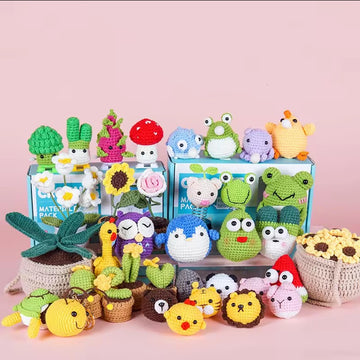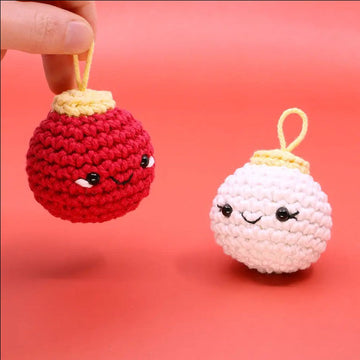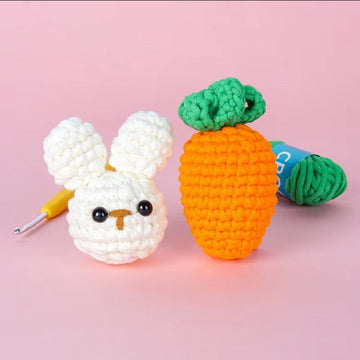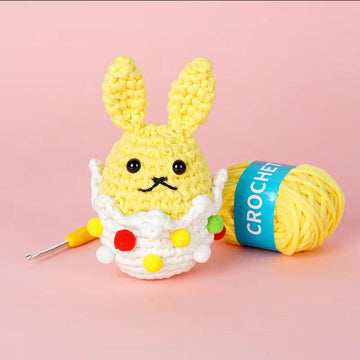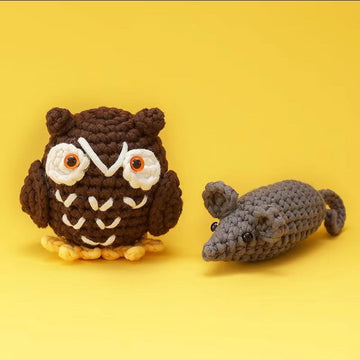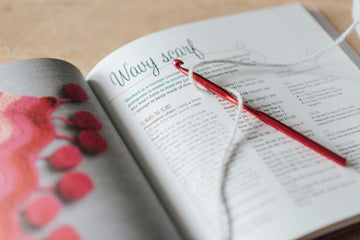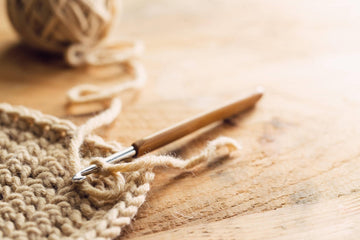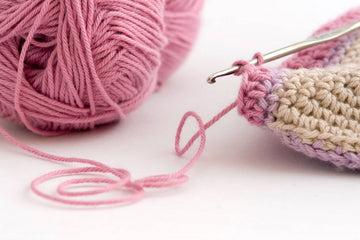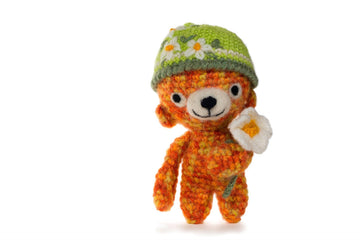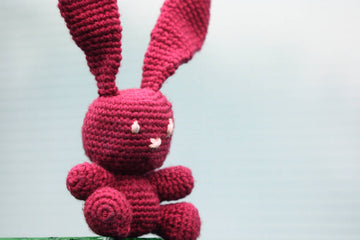Introduction
Crochet is a timeless and versatile craft that allows you to create a wide range of projects, from cozy blankets and stylish garments to intricate home decor pieces. At the heart of any successful crochet project lies the pattern - a set of instructions that guide you through the process of constructing your desired item. However, for beginner and intermediate crocheters, deciphering crochet patterns can often feel daunting and confusing.
In this comprehensive guide, we'll dive deep into the world of crochet patterns and equip you with the knowledge and skills to read them like a pro. Whether you're a seasoned crocheter looking to refine your pattern-reading abilities or a newcomer to the craft, this post will provide you with the tools and techniques you need to interpret crochet patterns with confidence and ease.
From understanding the basic crochet terminology and abbreviations to mastering the art of reading charts and schematics, we'll cover all the essential elements you need to become a crochet pattern-reading expert. By the end of this article, you'll be able to approach any crochet pattern with a keen eye, tackle intricate stitches and techniques, and successfully complete your desired projects.
So, let's get started on your journey to becoming a crochet pattern-reading pro!
| Table of Contents |
| Introduction |
| Understanding Crochet Terminology and Abbreviations |
| Interpreting Crochet Pattern Sections |
| Reading Crochet Charts |
| Tackling Crochet Pattern Techniques |
| Tips for Reading Crochet Patterns Effectively |
| Conclusion |
Understanding Crochet Terminology and Abbreviations

The first step to deciphering crochet patterns is to familiarize yourself with the basic terminology and abbreviations used throughout the instructions. Crochet has its own unique language, and being able to understand the meaning of the various stitches, techniques, and measurements is crucial for successfully interpreting a pattern.
Crochet Stitches and Abbreviations
At the core of crochet are the various stitches that form the foundation of your projects. The most common crochet stitches and their corresponding abbreviations are:
Chain (ch)
Slip Stitch (sl st)
Single Crochet (sc)
Half Double Crochet (hdc)
Double Crochet (dc)
Treble Crochet (tr)
Double Treble Crochet (dtr)
Triple Crochet (trc)
Quadruple Crochet (qdc)
It's important to note that crochet patterns may also include more advanced stitches, such as the Popcorn Stitch, the Bobble Stitch, or the Cluster Stitch, each with their own unique abbreviations.
Crochet Terminology
In addition to the stitch abbreviations, crochet patterns often use a variety of other terms and abbreviations to describe techniques, measurements, and instructions. Some common crochet terminology includes:
Gauge (g)
Repeat (rep)
Round (rnd)
Row (r)
Skip (sk)
Stitch(es) (st/sts)
Work (w)
Yarn Over (yo)
Bind Off (BO)
Cast On (CO)
Understanding these basic terms and abbreviations is essential for being able to follow crochet patterns accurately. Take the time to familiarize yourself with the most common crochet terminology, and refer back to it as needed while working on your projects.
Interpreting Crochet Pattern Sections
Crochet patterns are typically divided into several key sections, each providing essential information for the successful completion of your project. Let's explore the main components of a crochet pattern and how to interpret them:
Pattern HeadingAt the top of a crochet pattern, you'll typically find the pattern heading, which includes the following information:
Project Name
Skill Level (beginner, intermediate, advanced)
Finished Measurements
Materials Needed (yarn, hook size, notions, etc.)
Carefully review the pattern heading to ensure that the project is suited to your skill level and that you have all the necessary materials on hand before beginning.
Gauge Information
The gauge section of a crochet pattern provides critical information about the size and tension of your stitches. It's usually presented as a specific number of stitches and rows per inch or centimeter, achieved using the recommended hook size and yarn. Checking your gauge against the pattern's specifications is essential for ensuring that your finished project will match the intended size.
To check your gauge, follow the instructions in the pattern and crochet a small swatch, typically 4 inches (10 cm) square. Count the number of stitches and rows within the swatch, and compare the measurements to the pattern's gauge. If your gauge differs, you may need to adjust your hook size to achieve the correct tension.
Stitch Explanation
The stitch explanation section provides a breakdown of the various crochet stitches and techniques used throughout the pattern. This section is particularly helpful for beginner crocheters, as it can include step-by-step instructions and illustrations for executing each stitch.
Pay close attention to the stitch explanations, as they will help you understand the construction of your project and ensure that you're performing the stitches correctly.
Pattern Instructions
The pattern instructions are the heart of the crochet pattern, outlining the step-by-step process for creating your project. These instructions are typically written out in a row-by-row or round-by-round format, with detailed descriptions of the stitches, increases, decreases, and any special techniques required.
When reading the pattern instructions, be sure to follow them carefully and pay attention to any notes or special instructions that may be included. It's also a good idea to mark your progress as you work through the pattern to keep track of where you are.
Schematics and Charts
Many crochet patterns also include schematics and charts, which provide visual representations of the project's construction and shaping. Schematics are flat diagrams that show the project's dimensions and measurements, while charts depict the stitch patterns and placement.
Interpreting schematics and charts can be extremely helpful, as they can provide a clear, visual reference to supplement the written instructions. Take the time to study these visual aids, as they can often clarify aspects of the pattern that may be unclear in the written text.
Reading Crochet Charts

Crochet charts are a visual representation of the stitch pattern used in a project. They can be an incredibly useful tool for understanding and following crochet patterns, especially when working on more complex designs.
Here's a breakdown of how to read and interpret crochet charts:
Orientation
Crochet charts are typically read from right to left, with the first row (or round) at the bottom of the chart and successive rows stacked above it. This mimics the way you would work the stitches from the bottom up.
Symbols
Each square or symbol on the chart represents a specific crochet stitch or technique. The key to the chart will provide a legend explaining the meaning of each symbol used.
Common crochet chart symbols include:
Single crochet (sc)
Double crochet (dc)
Treble crochet (tr)
Slip stitch (sl st)
Chain (ch)
Increase
Decrease
Reading the Chart
Start by locating the first row or round on the chart, and then work your way up, stitch by stitch, following the symbols. Pay close attention to any special stitches or techniques that may be indicated, such as increases, decreases, or color changes.
Shaping and Stitch Placement
Crochet charts can also be used to visualize the shaping and stitch placement of a project. The arrangement of the symbols on the chart can help you understand how the stitches are distributed to create the desired shape, such as a circle, square, or triangle.
Skill Level
Crochet charts can range in complexity, from simple stitch patterns to intricate lace or cable designs. The more symbols and techniques included in the chart, the more advanced the project is likely to be.
Supplementary Instructions
Even with a comprehensive crochet chart, the pattern may still include written instructions to clarify certain steps or techniques. Be sure to read through the entire pattern, including any notes or special instructions, to ensure you have a complete understanding of the project.
By familiarizing yourself with the basic elements of crochet charts and learning how to interpret them, you'll be well on your way to tackling even the most complex crochet patterns with confidence.
Tackling Crochet Pattern Techniques

Crochet patterns can often include a variety of specialized techniques and stitches that may be new to you. Don't let these intimidate you – with the right approach and a little practice, you can master even the most intricate crochet skills.
Here are some tips for tackling common crochet pattern techniques:
Increases and Decreases
Increases and decreases are essential for shaping your crochet projects, from the simple increases used in a classic granny square to the more complex decreases found in garment patterns.
When you encounter an increase or decrease in a pattern, pay close attention to the specific instructions. Look for keywords like "2 sc in next st" (increase) or "sc2tog" (decrease) and follow the technique carefully.
Changing Colors
Changing yarn colors mid-project can add beautiful visual interest to your crochet, but it requires a bit of finesse. Patterns will typically provide instructions on how to properly join a new color and carry the unused yarn up the side of your work.
Take your time when changing colors, and practice the technique on a small swatch before applying it to your main project.
Working in the Round
Many crochet projects, such as hats, bags, and amigurumi, are worked in the round, using a continuous spiral of stitches rather than traditional rows.
When working in the round, pay close attention to the pattern's instructions for joining rounds, maintaining stitch counts, and evenly distributing increases or decreases.
Shaping and Stitch Patterns
More advanced crochet patterns may incorporate shaping techniques, such as short rows or intricate stitch patterns, to create unique shapes and textures.
Study the pattern's instructions and any accompanying charts or schematics to fully understand how the shaping and stitch patterns are constructed. Take the time to practice the techniques on a swatch before attempting them on your final project.
Blocking and Finishing
Finally, don't forget the importance of blocking and finishing your crochet projects. Many patterns will include instructions for blocking, as well as tips for seaming, edging, and adding any final embellishments.
Carefully follow the pattern's finishing instructions to ensure your project turns out exactly as intended.
By approaching each new crochet technique with patience, attention to detail, and a willingness to practice, you'll steadily build your skills and confidence, allowing you to tackle even the most complex crochet patterns.

Tips for Reading Crochet Patterns Effectively
Now that you have a solid understanding of the key elements of crochet patterns, let's explore some additional tips and strategies for reading them effectively:
Read the Pattern Thoroughly
Before you begin a new crochet project, take the time to read through the entire pattern, from start to finish. This will help you familiarize yourself with the overall construction of the project, identify any challenging techniques or areas that may require additional practice, and ensure that you have all the necessary materials on hand.
Highlight and Annotate
As you read through the pattern, use a highlighter or pen to mark important information, such as the skill level, finished measurements, stitch explanations, and any special instructions. This will make it easier to reference key details as you work on your project.
Familiarize Yourself with the Stitches
If the pattern includes stitches or techniques that are new to you, take the time to learn them before starting your project. Watch tutorial videos, practice the stitches on a swatch, and refer to crochet stitch guides to ensure you have a firm grasp of the required skills.
Pay Attention to Stitch Counts
Maintaining the correct stitch count is crucial for the success of your crochet project. Carefully follow the pattern instructions, counting your stitches at the end of each row or round to ensure you're on the right track.
Utilize Stitch Markers
Stitch markers can be incredibly helpful when working on crochet patterns, as they allow you to keep track of important points, such as the beginning of a round, the placement of increases or decreases, and the transition between different sections of the project.
Take Notes and Adjust as Needed
As you work through a crochet pattern, don't be afraid to take notes or make adjustments to the instructions. If you find that a technique or stitch isn't working for you, make a note of it and experiment with alternative approaches. Crochet is a highly customizable craft, and being adaptable is key to your success.
Consult Additional Resources
If you encounter a particularly challenging aspect of a crochet pattern, don't hesitate to consult additional resources, such as online tutorials, crochet forums, or even the pattern designer themselves. The crochet community is often eager to offer guidance and support to fellow crafters.
By incorporating these tips into your crochet pattern-reading practice, you'll develop the skills and confidence needed to tackle even the most complex patterns with ease.

Conclusion
WOOHOBBY is a go-to destination for hobby enthusiasts seeking well-designed, engaging DIY kits. Whether you're an aspiring model builder, an art lover, or someone who enjoys crafting home decor, WOOHOBBY has a diverse selection of kits to suit your interests. The kits are known for their attention to detail, comprehensive instructions, and top-notch materials, making the assembly process both enjoyable and rewarding. If you're looking to dive into a new hobby or expand your creative skills, WOOHOBBY's kits are an excellent choice that will keep you engaged and inspired.
Remember, the more you practice and apply these skills, the more comfortable and confident you'll become in your ability to interpret and execute even the most intricate crochet patterns. So, grab your hook, your yarn, and dive into your next crochet project with the knowledge and tools you need to succeed.
Happy crocheting!
